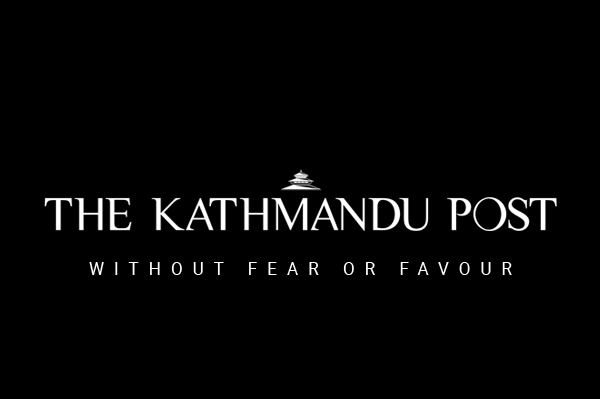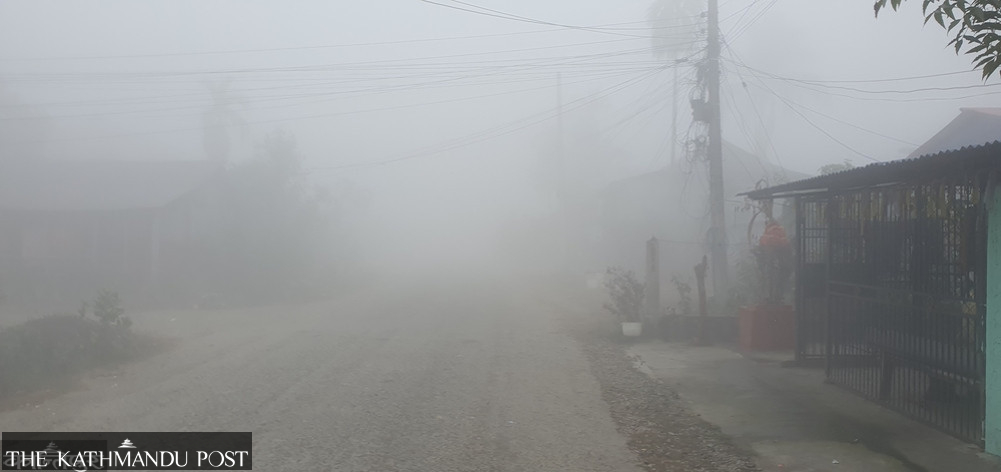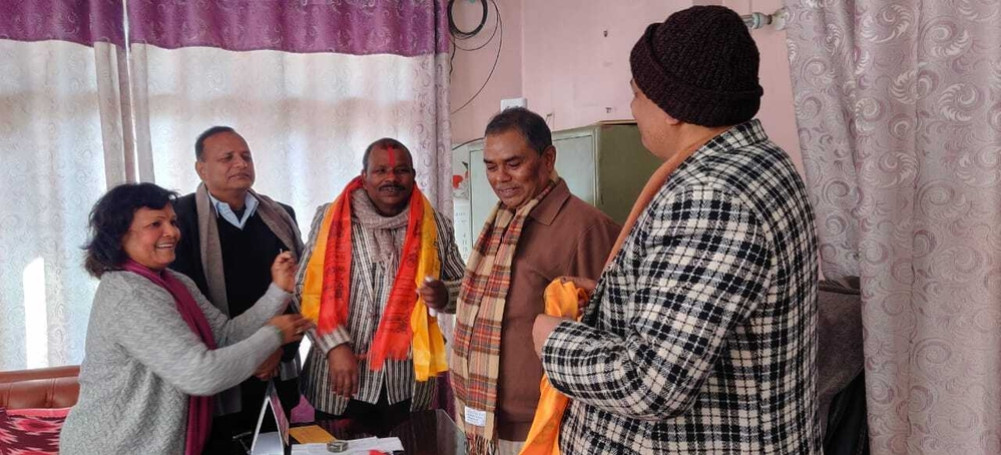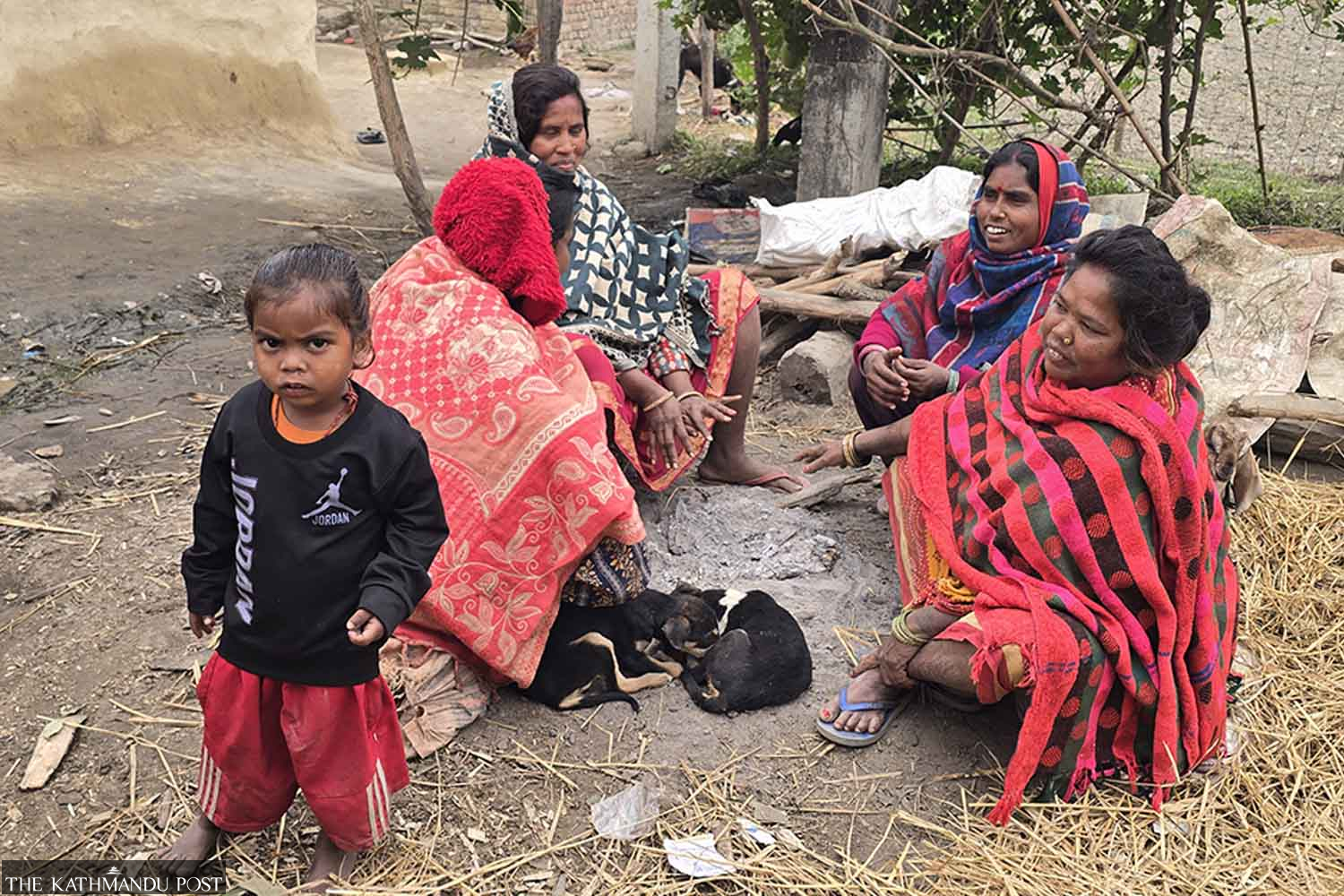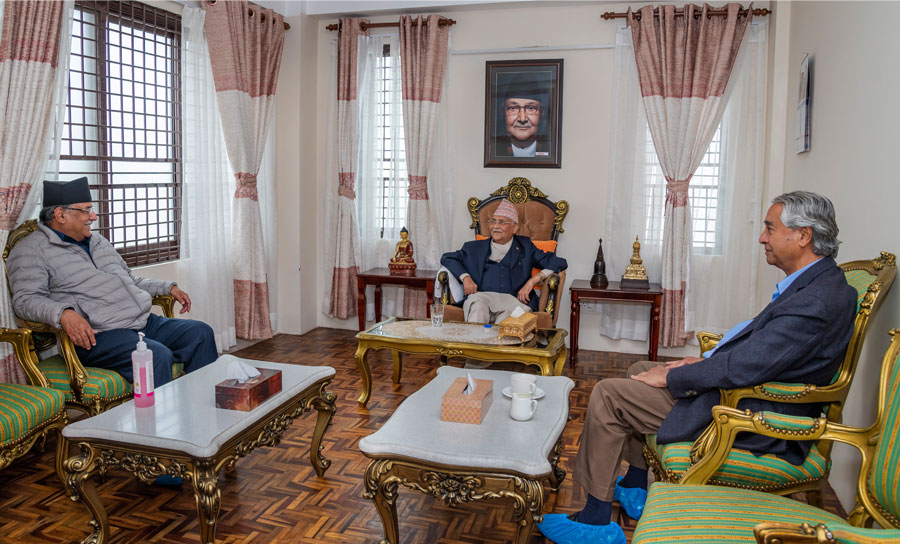National
How politicisation is dragging Kathmandu University down
Ever since the appointment of vice-chancellor Ram Kantha Makaju, allegations of financial impropriety and a monopoly over decision-making have continued to haunt the university..JPG)
Binod Ghimire
Ever since the new year began, a large group of around 150 teachers and employees have been gathering at Kathmandu University’s central offices in Dhulikhel to protest. They’ve been demanding that the university implement an agreement signed on September 16. Owing to the protests, final exams for the University’s School of Arts and Education have been postponed and students don’t know when they will be able to go back to class. Similarly, the entrance tests for the masters level have been obstructed and it is sure the classes will not begin from February as per the academic calendar.
Protests, demonstrations and obstruction of colleges are fairly regular in the country’s various universities. Examinations at Tribhuvan University, the country’s oldest and largest university, have been postponed countless times due to protests by teachers, staff or students.
But Kathmandu University was supposed to be different.
This is the first time, ever since its establishment in 1991, that the university has been paralysed for nearly a month by protests. In its nearly two decades of operation, the university has been mercifully free of the political meddling that has long been a salient feature of Nepal’s universities.
But there are now fears among students and educators that Kathmandu University too might be going the way of Tribhuvan University, sacrificing academic excellence and the welfare of students on the altar of political patronage.
A different kind of university
.JPG)
The progenitor of Kathmandu University was the Kathmandu Valley College, founded in 1985 by educationist Suresh Raj Sharma, who was also behind the Council for Technical Education and Vocational Training. The Kathmandu Valley College, which was located in Tangal, was at first affiliated with Tribhuvan University but Sharma lobbied to turn the college into a new, full-fledged university that would operate on a different model. On November 20, 1991, Parliament passed the Kathmandu University Act, establishing Kathmandu University as an autonomous institution of higher learning in the “non-governmental sector”.
The university was established as a self-sustaining public entity with very little governmental support. Although the prime minister is the chancellor of the university, as they are with all other universities, the vice-chancellor remained an independent figure, appointed by the prime minister on the recommendation of a three-member committee formed by the university Senate. From the very beginning, Kathmandu University, because it received few public funds, was largely free of political meddling. Even a majority of its infrastructure was constructed with donations.
According to Sharma, the only intention of the founders was to develop an exemplary academic institution in the country and prove that Nepalis themselves are capable of doing so.
Currently, there are over 12,000 students at the university’s main campus in Dhulikhel and its branch campuses in Hattiban, Balkumari and Bhaktapur. In 1992, when it first started, it offered an intermediate degree through its School of Sciences. A year later, it set up the School of Management, introducing the Masters of Business Administration for the first time. The bachelor’s programme for Science and Arts started in 1994 and the School of Engineering was also established the same year.
“We had embarked on this journey aiming to create an institution that would be a centre of excellence, but we didn’t know how far we would reach,” said Sharma. “The university expanded with the trust of people and our donors. There was also government support.”
Sharma also says he is personally happy to have resisted various attempts to politicise the institution during his tenure.
“The university has maintained the standard of quality,” said Sharma. “It is saddening to see the attempts to drag it into controversy. The university belongs to everyone, from its leadership to the teachers and staff, and it is their responsibility to sort out these issues before it is late.”
Students at the university too say that teachers and staff might have their issues with the leadership but academic activities cannot be hampered under any pretext.
“Though some of the protesters' demands are targeted at holding the authorities accountable, it is wrong to obstruct teaching and learning activities in the name of building pressure,” Sushant Acharya, a fourth-year student of Media Studies at the university’s School of Arts, told the Post. “The university is gradually losing its identity as an institution that is free from politics.”
The issue at hand
.jpg)
For years, the university’s teaching staff and employees have been demanding the formation of independent associations. Though a Faculty Welfare Council and a Staff Welfare Council both exist, protesting teachers and employees argue that these bodies lack an independent voice since they are subordinate to the university. They have been demanding that the university recognise the Kathmandu University Professor’s Association (KUPA) and Kathmandu University Staff Association (KUSA) by revising its regulations.
The university, in September last year, had formed a three-member dialogue committee led by Bijay KC, a professor at the university, which on the 16th of the month signed a four-point agreement which includes recognition of the two associations and the formation of an independent probe committee to investigate alleged financial discrepancies under the present leadership. The agreement was signed on behalf of the KU Academic Council by vice-chancellor Ram Kantha Makaju and had also envisioned developing proper criteria for administrative appointments, including for the dean and the heads of departments, and ensuring the representation of teachers and staff in the decision-making process.
The two parties had agreed to call a special session of the Senate to endorse the agreement within a month. The Senate is the university’s highest decision-making body, followed by the Academic Council.
But with no sign of the Senate meeting nearly three months on, teachers and employees restarted their protests, padlocking the administrative and academic blocks. The protest, which started on the central campus in Dhulikhel, has gradually expanded to the Kathmandu University Schools of Arts and Education in Hattiban, affecting classes and examinations.
“Obstructing classes is our last resort. Had the university authority worked as per our agreement, the present situation could have been averted,” said Bibhuti Ranjan Jha, a KU professor who is also a former chairperson of the KUPA.
Following the protest, the Academic Council has now called the Senate meeting for January 27, but protesters are unconvinced. They believe that once they withdraw their protest, their demands will not be addressed. They believe that Makaju is hell-bent on not budging until the padlocks are removed.
A group of protesting teachers and staff who went to meet him to ask about starting a dialogue were humiliated and asked to leave his room. A video of his anger was widely circulated on social media, saying that it accurately depicted his attitude towards employees at the varsity. Protestors said that room for negotiation has narrowed significantly since Makaju belittled them.
Makaju, however, dismissed all allegations. He says he asked them to leave because they entered his chamber without an appointment. In an interview with the Post, he alleges that allowing KUPA and KUSA to operate could politicise the university. Currently, the two organisations are not affiliated with any political party and say that they are committed to not turning them into political entities.
But Makaju is not convinced.
“Allowing political entities in the university will be the university’s downfall,” he told the Post.
The September agreement doesn’t just authorise the two unions to operate but will also allow their representation in all of the university’s decision-making bodies, including the committee formed to probe financial ‘irregularities.’ Protestors say that the leadership fears that their participation in such bodies will put an end to the monopoly that the leadership has held for years.
Makaju presents a challenge
.jpg)
Those who have closely worked under the present leadership say it has long been apparent that Kathmandu University is now operating under Makaju’s orders. Makaju became the second vice-chancellor of the university in December 2012, after Sharma resigned.
“Decisions are no longer made--they are imposed,” said Bhola Thapa, a former university registrar who worked under Makaju for around five years.
Anyone who challenges Makaju’s decisions are targeted, said Thapa, who was at the university from its founding days and worked to establish the engineering department. Thapa quit in August 2018, arguing that Makaju had monopolised every decision--from finances to faculty appointments.
When Thapa resigned, he said that Makaju had pushed to allow three people--faculty members Lochan Rijal and Sagar Raj Sharma and staff member Dinesh Man Dangol--to handle a Rs150 million grant from the Thai government for the reconstruction of the Tripureshwor Shivalaya into the university’s Music Department. The decision was reversed after Thapa raised the issue during an executive committee meeting saying it was illegal.
Constitutional expert Bipin Adhikari, who was instrumental in setting up the University’s School of Law, also resigned from the position in March last year giving similar reasons.
It was Adhikari who took all necessary measures to establish the School of Law, from conducting a feasibility study to collecting funds and managing staff. However, despite all his contributions, the university authorities halted his promotion to professor.
“You cannot work in an institution where your dignity is not respected,” Adhikari told the Post.
The Executive Committee, which is led by vice-chancellor Makaju, was reluctant to award Adhikari a professorship, even though a selection committee had recommended that Adhikari be made a full professor. According to selection committee members, Makaju’s reluctance came from the fact that Adhikari was among 10 senior university officials who had written to the government protesting Makaju’s appointment as vice-chancellor.
Adhikari was not the only victim. The terms of numerous professors working as deans or department heads were not extended if they questioned the leadership. The term of educationist Man Prasad Wagle was not extended as dean of the School of Education, neither was Janaradan Lamichhane, biotechnology department chief, or Tanka Nath Sharma, dean of the School of Education. Thapa, Wagle and Lamichhane were all contenders for the position of vice-chancellor when Makaju was reappointed in 2017 for his second term.
“The university is a public entity but the present leadership is trying to run it like a private company,” said Wagle. “There is no culture of consultation and a kitchen cabinet takes every decision, which is generally not transparent.”
Critics of the incumbent leadership say that top positions are handpicked and appointed, rather than promoted. Makaju brought in Dammar Nepali, who was celebrated for establishing the Chilime hydropower plant, as dean of the School of Engineering. Nepali might be a successful engineer but according to a former university dean, he did not have any teaching experience. There were similar criticisms against the appointment of Rishikesh Wagle, a former district court judge, as dean of the School of Law.
Makaju, however, says that he appointed people from outside the university in order to blend theory with practice.
“I headhunted experts to lead departments for the betterment of the university,” he said. “Students can now do practicals along with studying theory, which was not the case earlier.”
Makaju said that he would rather jump to his death from a building than compromise on his principles.
“Those who are making these allegations must answer: what is their contribution to this institution?” he said.
But the moment Makaju was appointed vice-chancellor, there were controversies. Then vice-chancellor Sharma resigned in November 2012 when there were still two years remaining in his tenure. Although Sharma was nearing retirement age, there were many allegations in the media that he was under pressure to resign or provide affiliations to new medical colleges.
Makaju came from Dhulikhel Hospital, which is not part of the university. At the time of his appointment, there were allegations that the Baburam Bhattarai government had appointed him vice-chancellor on the condition that Morang’s Birat Medical College and Rupandehi’s Devdaha Medical College be granted university affiliation. They were eventually allowed to conduct MBBS courses as an extended programme.
Talking to the Post in December 2014, Makaju had said that the two colleges would operate entirely under Kathmandu University’s jurisdiction. Students would submit their fees at university, which will directly oversee the appointment of faculty members. However, except for paying the first fee instalment at the university, both medical colleges are now operating as independent entities that are affiliated to the university.
But his critics say that Makaju might be a headstrong person who takes decisions on his own but he is not in it for his own personal benefit.
“He just bulldozes the system and compels it to function the way he wants it to,” said a former university dean on condition of anonymity.
Makaju’s confidants too say that he worked hard to elevate Dhulikhel Hospital to its current heights but also admit that this working style could be seen as undemocratic and rude. That is just his personality, they say.
“Nobody who knows him and his contributions can accuse him of any wrongdoing,” said Deepak Dahal, administrative chief of Dhulikhel Hospital. “He has always worked to put others above himself.”
The university and the hospital
.jpg)
Dhulikhel Hospital is considered one of the country’s premier community hospitals and it has long worked in close proximity with Kathmandu University’s School of Medicine. Makaju and his team are largely credited with building Dhulikhel Hospital into the institution that it is from scratch.
But Makaju has long been reluctant to let go. He was director of the hospital for years but now, when he is vice-chancellor of the university, he continues to oversee activities at the hospital.
Teachers and university staff complain that Makaju is prioritising the hospital over the university. Resources that are supposed to go to the Kathmandu University School of Medicine have been used to develop infrastructure at the hospital, they say.
“Kathmandu University’s medical school should be developing its own teaching hospital but instead, all its funds are going towards Dhulikhel Hospital,” said Bed Mani Dahal, KUPA chairperson. The government has given 500 ropanis of land to the university to build a hospital of its own, but there’s currently only one building to study Basic Science there.
An agreement signed in 2003 between the university and the hospital says that the two institutions will be in partnership for 50 years. Another agreement, signed in 2004, further said that if the hospital ever closed, all of its infrastructure and property would go to the university. Sharma, who signed the agreement on behalf of the university, said that he had never envisioned the two institutions to separate, that they would always work together.
But, seven years later, in 2010, a new agreement signed by Makaju repealed the past deals, allowing either party to break their partnership with a notice of five-and-a-half years.
Teachers and students at the university are concerned that if Dhulikhel Hospital ever decides to detach itself from the university, the medical school will be paralysed as it lacks all infrastructure.
However, Dr Rajendra Koju, dean of the medical school, says that Makaju and his team have never used any of the university’s money for Dhulikhel Hospital.
“These allegations don’t have a bit of reality,” Koju told the Post.
But an agreement from February 2003 obtained by the Post shows that the hospital was given 11.5 ropanis of the university’s lands.
Protesting teachers and staff say that the university needs to come up with a white paper regarding all of transactions between the university and the hospital.
“The university authorities need to conduct a social audit of all the transactions to clear the air,” said educationist Wagle.
But from the outside, it appears that a lack of trust between the university authorities and the university employees is at the heart of the problem.
Devraj Adhikari, member-secretary at the University Grants Commission which oversees the country’s various universities, says that the ongoing problems at Kathmandu University are worrying.
“Kathmandu University is the only institution that is free from politics and has managed to maintain its quality,” said Adhikari. “It is the duty of the university officials, including its teachers and employees, to ensure that it doesn’t suffer the fate of the country’s other universities.”
***
What do you think?
Dear reader, we’d like to hear from you. We regularly publish letters to the editor on contemporary issues or direct responses to something the Post has recently published. Please send your letters to [email protected] with "Letter to the Editor" in the subject line. Please include your name, location, and a contact address so one of our editors can reach out to you.




 7.34°C Kathmandu
7.34°C Kathmandu
